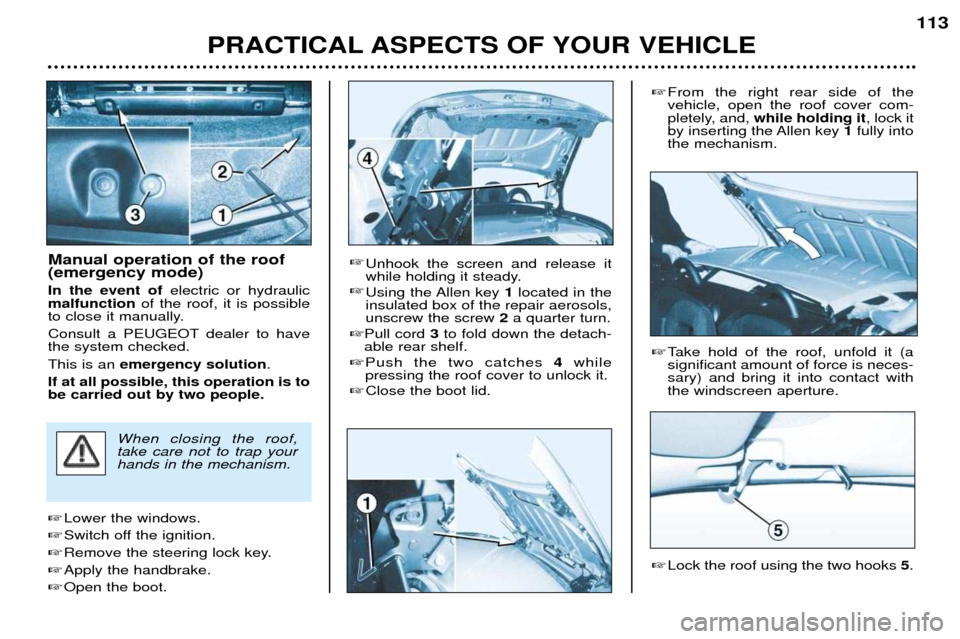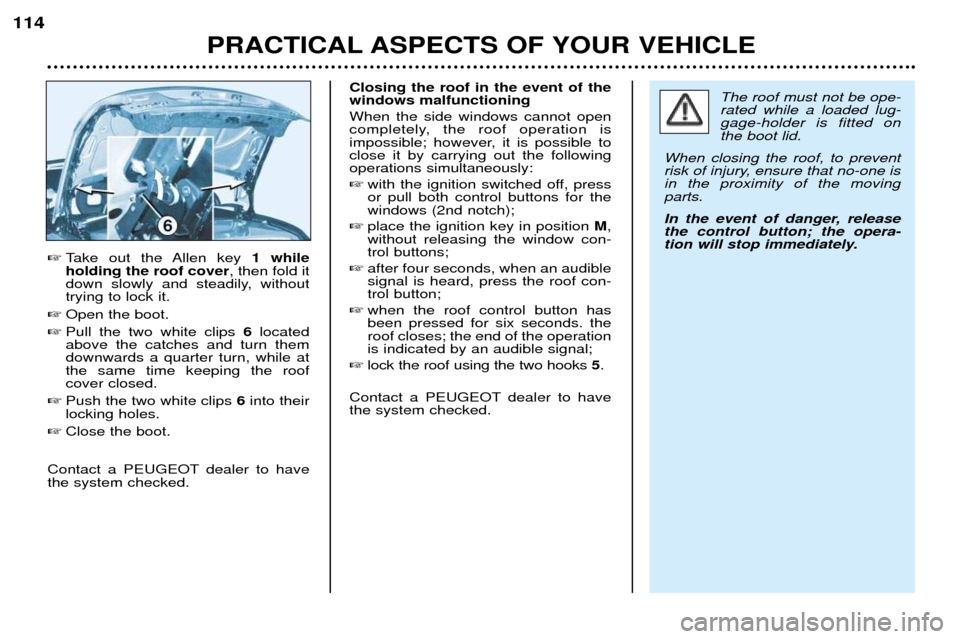Page 87 of 123
YOUR 206 CC IN DETAIL87
The normal operation of the ABS may make itself felt by slight vibra-tions of the brake pedal. In emergency braking, press very firmly without releasing thepressure.
The ABS Anti-lock Braking System*
When used with approved tyres in
good condition, the ABS increases thestability and manoeuvrability of yourvehicle, particularly on poor or slipperyroad surfaces. The anti-lock braking system comes into operation automatically whenthere is a risk of wheel lock.
Handbrake Locking When parking, pull the handbrake to immobilise your vehicle. Unlocking Pull the handle and press the button to release the handbrake.
* According to specification.
Page 97 of 123

PRACTICAL ASPECTS OF YOUR VEHICLE95
Punctures Because this version does not pos- sess a spare wheel, you have twoaerosols for temporary tyre repairsstored in an insulated storage box
1
secured by a strap to the right-handside of the boot. Using a repair aerosol (See also the instructions on the aerosols). �
If possible remove the foreign body which caused the puncture.
� Position the wheel so that the valve
is at the 2 o'clock or 10 o'clock posi-tion.
� Shake the aerosol vigorously befo-
re use. (In very cold weather, warmthe aerosol for a few minutes in yourhands).
� In one hand hold the valve.
� With the other, firmly push the end
of the aerosol tube onto the valve,keeping the aerosol centralised.
� Maintain the pressure firmly for one
minute, then immediately drive at
moderate speed to the nearest
garage. Aersosols enable a tempo-rary repair to be carried out(maximum speed 50 mph(80 km/hour)).
After use, it is necessary to replacethe tyre. Because the aerosols are pres- surised, they must not be exposedto a temperature higher than 50¡C. Keep them away from heat in their insulated storage box.
Page 108 of 123
PRACTICAL ASPECTS OF YOUR VEHICLE
104
Fuse no. Rating*
Functions*
7 15A Driving school accessories - Retro-fit alarm - Rain sensor
9 30A Hydraulic pump
10 40A Exterior mirror demisting 11 15A Wiper
12 30A Front windows
14 10A Engine fuse box - Air bags - Steering wheel stalks
15 15A Instrument panel - Multi-function display - Navigation control unit - Air conditioning - Radio
16 30A Door locking / unlocking controls - Deadlocking controls
20 10A Right brake light
21 15A Left brake light - 3rd brake light
22 30A Front courtesy light - Glove box lighting - Cigarette lighter
S1 Shunt PARC shunt
* According to specification
Page 115 of 123

PRACTICAL ASPECTS OF YOUR VEHICLE111
Bodywork maintenance
To preserve the paintwork and the plastic trim on your vehicle, we recom-
mend that you wash them regularly.
Ð by hand: there are no specific pre-
cautions to take;
Ð using an automatic car wash: repeated use of poorly maintained automatic car washes can lead tothe appearance of microscopicscratches which give the paintworka matt appearance (especiallyvisible on dark colours);
Ð using a high pressure washer: always follow the recommendationson the equipment (pressure andspraying distance). If there are damaged areas on the vehicle (painted bumpers, or head-lamps), it is not recommended todirect the high pressure jet onto
them. Wash these areas by hand. Also avoid the entry of water into the locks.
For all questions relating to the main-tenance of your vehicle, contact anapproved dealer who can advise youon quality products selected by ourdepartments.- Clean off bird droppings, resinous deposits, tar stains and grease marksas soon as possible;
(these all contain substanceswhich can cause serious damageto the paintwork).
- Do not use a dry or abrasive cloth, or detergent or solvent products toclean the double lens, complexsurface headlamps as they are fit-ted with polycarbonate glass cove-red in a protective finish.
- Do not use petrol, oil or cloth stain removers to clean the bodyworkand plastic parts of your vehicle.
- To prevent the development of bodywork corrosion as a result ofaccidental damage (stone chips,scratches etc.), have them repai-
red swiftly.
Page 117 of 123

PRACTICAL ASPECTS OF YOUR VEHICLE113
Manual operation of the roof (emergency mode) In the event of
electric or hydraulic
malfunction of the roof, it is possible
to close it manually.
Consult a PEUGEOT dealer to have the system checked. This is an emergency solution .
If at all possible, this operation is to be carried out by two people. � Lower the windows.
� Switch off the ignition.
� Remove the steering lock key.
� Apply the handbrake.
� Open the boot.�
Unhook the screen and release it
while holding it steady.
� Using the Allen key 1located in the
insulated box of the repair aerosols,unscrew the screw 2a quarter turn.
� Pull cord 3to fold down the detach-
able rear shelf.
� Push the two catches 4while
pressing the roof cover to unlock it.
� Close the boot lid.
�From the right rear side of the vehicle, open the roof cover com-
pletely, and, while holding it , lock it
by inserting the Allen key 1fully into
the mechanism.
� Lock the roof using the two hooks 5.
When closing the roof, take care not to trap yourhands in the mechanism.
� Take hold of the roof, unfold it (a significant amount of force is neces-sary) and bring it into contact withthe windscreen aperture.
Page 118 of 123

PRACTICAL ASPECTS OF YOUR VEHICLE
114
�
Take out the Allen key 1 while
holding the roof cover , then fold it
down slowly and steadily, without trying to lock it.
� Open the boot.
� Pull the two white clips 6located
above the catches and turn themdownwards a quarter turn, while atthe same time keeping the roofcover closed.
� Push the two white clips 6into their
locking holes.
� Close the boot.
Contact a PEUGEOT dealer to havethe system checked.
The roof must not be ope- rated while a loaded lug-gage-holder is fitted onthe boot lid.
When closing the roof, to prevent
risk of injury, ensure that no-one isin the proximity of the movingparts.
In the event of danger, release the control button; the opera-
tion will stop immediately.Closing the roof in the event of the windows malfunctioning When the side windows cannot open
completely, the roof operation is
impossible; however, it is possible toclose it by carrying out the followingoperations simultaneously: � with the ignition switched off, press or pull both control buttons for thewindows (2nd notch);
� place the ignition key in position M,
without releasing the window con-trol buttons;
� after four seconds, when an audiblesignal is heard, press the roof con-trol button;
� when the roof control button hasbeen pressed for six seconds. theroof closes; the end of the operationis indicated by an audible signal;
� lock the roof using the two hooks 5.
Contact a PEUGEOT dealer to havethe system checked.
Page 119 of 123

PRACTICAL ASPECTS OF YOUR VEHICLE115
206 CC Accessories
For your PEUGEOT only use accessories and original parts approved by the manufacturer.
These accessories and parts are all adapted to your PEUGEOT, after being tested and approved for reliability and safety, which
PEUGEOT cannot guarantee for other products.
A wide choice of original accessories, approved by PEUGEOT, is available through the dealer network. They all carry the
PEUGEOT guarantee. Safety:
Anti-theft alarm, lift detection alarm, window engraving, wheel locks, signalling triangle, first aid kit, ...
Protection: Covers suitable for side air bags, carpets, boot storage tray, É
Communication: Telephone, satellite navigation system, CD changers*, audio systems, speakers, audio trim, ...
Personalisation: Alloy wheels, trims, mud flaps*, aluminium and wood panel trim...
Comfort: Centre armrest, can holder, CD or cassette storage, telephone console, Win stop, ...
Leisure: Towbar, boot rack , snow chains, ...
Children: Booster seats and child seats, ...
Maintenance products: Screenwash, interior and exterior maintenance and cleaning products.
* Available during the year.